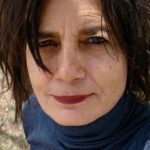Dru Philippou
Wings of Light: The Landscapes of Pierre Bonnard
I. Window Open on the Seine
She spends most afternoons at her window, and today is enjoying the wild irises she picked from a nearby meadow. The book on her lap is open to Pierre Bonnard’s painting, Fenêtre ouverte sur la Seine. The artist, who revealed little about his personal life, recorded notes in his diary such as gray sky or fine or overcast to help him remember what he had seen that day or what he might later paint. Over time, his compositions grew increasingly impressionistic, yet real enough to fill the woman’s world. She peers through Bonnard’s window to the river’s blue, carving a path through dense foliage. Beyond the water, the land flattens out, with daubs of blue receding toward the horizon. She feels the earth beneath her feet and imagines the blue brushstrokes as irises. She tilts her face to the lemon-white clouds and more blue. Her face, like the painting, is luminous.
a sudden smudge of blue from the iris on a dreary day the comfort of its fragrance tethering memories
II. Yellow in the Earth
The path fromthe Musée Bonnard follows the Canal de la Siagne near the painter’s studio, Le Bosquet, and evokes thoughts of his daily rambles into the hillsides. Perhaps it was on such a sunlit morning as this that he hurried home to paint Décor méridional, le Cannet.
where the road drops the village trees sway in autumnal yellows his satchel weighted with color and light burst berries scattering tiny seeds across the ground . . . mysterious pigments stain his fingers blues, greens, oranges recede down the valley the day’s warmth perpetually shifting these elusive hues silhouetted against a nameless sky the wingtips of his visions curving and vanishing into incandescence the painter’s first gentle brushstrokes on a wall-pinned canvas here, in this liminal world yellow reveals its secret
III. Journey Into Light
the way ahead misted with moonlight as if he could trace each stage of his life in a wisp of color
Bonnard’s almond tree, flowering against a sapphire sky, dominates his canvas—a white expanse of pulsating dashes and orbs offsetting the fiery tones of vegetation. Despite his efforts to unravel the mystery of white, he inevitably returns to yellow—the color of light, as he once said. A week before he dies, and still thinking about this painting that he’d begun years before, he adds a final yellow glow over a green patch.
the light briefly flickering on the painter’s brush touches the sun at last emptying everything into white his life’s work lifted on the wings of a butterfly into the next century almond blossoms still cascading to earth
Notes:
1. Pierre Bonnard. Fenêtre ouverte sur la Seine, 1911-1912. Musée des beaux-arts Jules Chéret de Nice. Wikimedia Commons (accessed April 4, 2023).
Words in italics: Bonnard: Essays Sarah Whitfield and John Elderfield, Harry N. Abrams, Inc., Publishers, 1998. https://www.moma.org/calendar/exhibitions/212. (accessed April 4, 2023).
2. Pierre Bonnard. Décor méridional, le Cannet, 1928. Musée d’Orsay, Paris, France. (accessed April 4, 2023).
3. Pierre Bonnard. L’Amandier en fleurs, 1946-47. Musée Orsay, France (accessed September 18, 2023).
Italics in tanka 3 is from a quote by Bonnard: I should like to present myself to the young painters of the year 2000 with the wings of a butterfly. The New Criterion. (accessed April, 4, 2023)
About the Author

Dru Philippou currently lives in northern New Mexico, where hiking in the desert wilderness nourishes her spirit and her writing. Her haibun “Afterlife” won first place in the Haiku Society of America’s 2021 Haibun Awards. Also, her haibun “Pilgrimage” won first place in 2023 in the same contest. She is the author of A Place to Land, a tanka prose memoir.
